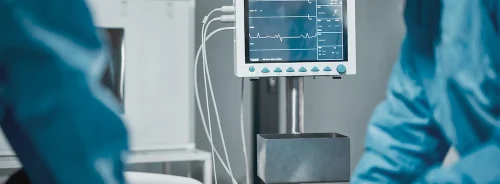ICU Management & Practice, ICU Volume 11 - Issue 2 - Summer 2011
Authors
Katie Went, BSc(Hons), PhD
Research Assistant
School of Computing
University of Dundee
Dundee, Scotland
[email protected]
Ian Ricketts, BSc, PhD, FBCS, FRSA, FRSM, MIT, MIEEE, ACM
Chair of Assistive Systems and Healthcare Computing, and
Professor
School of Computing
University of Dundee
Dundee, Scotland
[email protected]
Shaun McLeod
MBChB, FRCA, Dip ICM
Consultant
Department of Anaesthesia
NHS Tayside
Dundee, Scotland
[email protected]
Kenny Scott, BSc(Hons)
eHealth Department
NHS Taside
Dundee, Scotland
[email protected]
Patient safety in the healthcare sector has improved significantly with the appropriate use of information technology. However, there is increasing evidence that insufficient involvement of users in the design process can result in systems that fail to achieve their full potential. This case study describes one approach taken to user engagement in the design and implementation of an electronic prescribing and administration system.
Design of Healthcare Systems
Healthcare systems frequently involve multidisciplinary users working in busy and stressful environments. In these complex work environments, where safety is critical, divergence between the way in which users work and the technologies that support them can have unintended consequences and cause inefficiencies.
One approach to gaining an understanding about the users and their workflow is ethnography. Ethnography has been used to observe clinicians and their work practices (Harper et al. 1997). Rapid design prototyping is another approach that can be used to generate insights into what a solution may be. Whilst ethnography provides an understanding to users work practices, prototyping puts users in touch with the design through tangible artifacts and has been associated with successful implementation of healthcare systems (Parle and Lassere 2008). Rapid prototyping allows stakeholders to be engaged in the design process and allows a collaborative solution to be produced. “Including all points of view makes it more like- ly that traditional assumptions about problems and expected solutions will be challenged and possibly overturned” (Nemeth 2004). However the success of rapid prototyping does rely on the engagement of appropriate stakeholders.
User involvement presents users with an opportunity to contribute to the design and develop their understanding of the problem, in addition to providing designers with an understanding of the users’ work and how the system could be designed to enhance current practice.
Participatory design is a recommended form of user involvement.This approach involves the user, actively participating as a member of the design team, to help ensure that the designed product meets their needs. Gulliksen et al. (2003) encourage active participation with representative users actively participating, early and continuously throughout the entire development process and system lifecycle.
User involvement is not always a straightforward task. Wilson et al. (1997) provided an insight into the particular challenges of adopting a collaborative approach. Obstacles to the process ranged from gaining access to the users, organising and motivating ongoing user involvement and facilitating contributions to the design.
Developing an Electronic Prescribing System
An electronic prescribing and administration system was designed to actively reduce prescribing errors and be highly usable.The development of the electronic prescribing and administration system was based on the lifecycle model for inter-action design (Preece et al. 2002).This user-centred lifecycle involves four basic activities, which inform one another and are repeated continuously throughout the cycle.
A key characteristic in the process is the ongoing involvement of users (Preece et al. 2002).
Authentic User Participation
Fundamental to the success of a system, is the quality and experience of the user participation, with hands-on user experience being a prerequisite for real user participation (Bødker and Grønbæk 1997). Thus, in this project it was important to explicitly involve users throughout the whole process, to maintain engagement and motivation and to allow effective participation.
A project team was formed at the outset, consisting of clinicians from Ninewells Hospital, Dundee and a group from the School of Computing, University of Dundee.The team comprised two consultants in anaesthesia and intensive care, the principal clinical pharmacist for critical care, the intensive care specialist liaison nurse, a nursing education specialist, a professor of interactive systems design, a professor of assistive systems and healthcare computing and a PhD computing student. Some of the individuals on the team changed during the three-year period but the professional composition was unaffected.
Maintaining Engagement
The established team was involved throughout the design, development and implementation of the system. During the three-year period, a total of forty-eight official meetings were held.
The meetings were organised to reinforce the participatory design approach. The frequency of the meetings ranged between fortnightly and monthly. Agendas were circulated in advance of the meetings with a reminder of actions from the last meeting. It was important that the meetings kept to the allocated times, all items on the agenda were addressed within the designated time and that any unresolved items were carried forward to the next meeting. The agendas and chairing were well received by the team as they allowed the meetings to be kept to time, structured and thus potentially more productive. All of the meetings were held at the hospital and were scheduled for either one or two hours accumulating a total of 227 hours of user participation.
The Participatory Approach
Activities of the participatory design approach included field studies and evolutionary prototyping. It was firstly important for the computing side of the team to gain an understanding of the intensive care environment and the way in which the different user groups worked and interacted with one another in ICU. To supplement surveys of prescription non-compliance, an ethnographic approach was adopted, where users were directly observed in the ICU with the observer granted permission to interrupt users at any time, to ask questions and converse about their work. In total, three official observations were undertaken at different times of the day; one session was at the shift change which was also the time when most medications are administered, the other two sessions occurred at random between 9 am and 5 pm. Observing the interaction between doctors, nurses and pharmacist in the ICU provided an insight into how the system could be designed to support their work practices and allowed questions to be raised about the basic assumptions that were taken for granted by the users.
Site visits to two UK hospitals that used electronic prescribing were also undertaken to gain an understanding of current systems and to learn from practioners’ experiences of using them.
Evolutionary prototyping, in which the system is presented to the end users in a series of iterative prototypes, each of which gradually adds functionality, was employed. The design began as a set of paper-based prototypes that quickly enabled a visualisation of the system providing a basis for agreeing the requirements. These paper prototypes led to the development of the evolutionary software prototype. To sustain engagement and enthusiasm, regular meetings to evaluate the evolving prototype were held with the interdisciplinary team. The typical structure of these meetings was a walk- through of the prototype, with particular emphasis on recent amendments, followed by a managed discussion during which the users identified improvements and agreed recommendations for changes to the interface, to support best practice.
Adopting a process that allowed authentic user participation ensured the evolving system focused on the clinicians’ requirements and allowed them to actively contribute to the design decisions.
The participatory approach also provided the computing members of the team with an improved understanding of the users’ practice.
Evaluation
The electronic prescribing and administration system was evaluated on 16 different patients over a five month period; 15 paper charts and 16 electronic charts were viewed and assessed. The system was used at one bed for 76% of the time by 15 doctors, 46 nurses and the critical care pharmacist. The prescription charts, both electronic and paper, were compared for impact on prescribing errors. It was found that the overall level of prescription compliance when using the electronic system was significantly higher (91.67%) compared to the paper system (46.73%). A sample of clinicians who had used the systems were interviewed to gather their views. The sample comprised 9 doctors, 10 nurses and a pharmacist. Overall, the electronic system was preferred.
Conclusion
Authentic user participation not only involved the users in the design, development and implementation but was also used to elicit knowledge about the healthcare domain and work processes. Evolutionary prototyping was used to overcome difficulties with users envisioning their needs.The tangible product was used to elicit and validate requirements.
The authentic user participation was over a sustained period of time. Sustained engagement provided clinicians with a period of time to reflect and consider different problems and situations that are encountered in their work environment and the way in which the electronic system could/would be able to accommodate. Another advantage was the trust that emerged over time between the clinicians and computing members of the team; this meant that the clinicians felt comfortable to disclose their experience of non-compliances. This allowed a further understanding of the types of non-compliances that occurred and allowed a further exploration of ways in which the system could prevent future occurrences.
Extensive user involvement can cause users to lose motivation and the process can become counter intuitive.Wilson et al. (1997) highlighted that involving users in an effective way is a complex issue, with factors such as user demotivation preventing the users from contributing effectively. However, in this study, by careful management of the process and the team, achieved through the regular meetings, the users remained engaged and enthusiastic throughout the design and development process.
The organisation of the team and their management were also important aspects of the process, as was the make up of the team with a representative sample of users.Their systematic involvement throughout the design, development and implementation of the system provided greater opportunity for the users to influence the design, increasing their sense of ownership of the system.
Future Work
The approach taken to create a usable electronic prescribing and administration system, that enhanced compliance with the medical prescribing process, may be capable of wider application in other healthcare application areas. Funding has been secured, in collaboration with NHS Tayside and Knowledge Transfer Partnership to take an authentic participatory approach to the design and development of a system for the surgical high dependency unit. The system will enable real-time data to be entered on certain healthcare processes, the environment in which these processes are occurring, and the outcomes from these processes whilst providing real-time feedback on this information to enable early intervention if a problem is identified.
References:
For references please send a request to [email protected]






